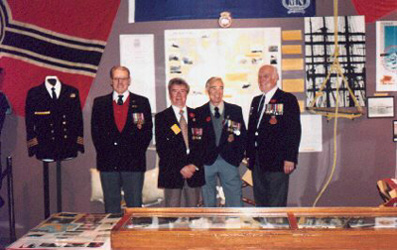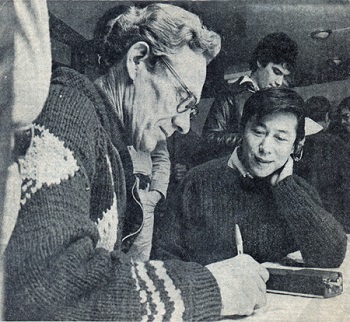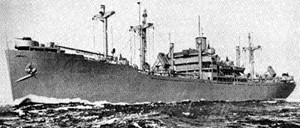EPILOGUE
Before he became sick with the leukemia which was to
take his life, Chuck Betsworth,
along with many of his Merchant Navy friends, was very
involved
with the
Canadian Merchant Navy Veterans Association
(CMNVA).
The organisation had been
founded in 1982 by Merchant Navy
veteran
Merv Hartley,
at which time it was called the
Canadian Merchant Navy Association.
During the war the men and women of the
Merchant Navy had been officially acknowledged
as the
"Fourth Arm of the Service", but once
the war ended they were
forgotten
and neglected.
Merv Hartley and the CMNA
sought to
redress those wrongs and focus
public attention
on the plight of
aging Merchant Navy veterans.
Sadly, Merv Hartley died in 1987,
but other determined
men and women carried on
in his place and finally in 1998, after
a long struggle and many set-backs, the
Canadian Merchant Navy Veterans
were finally granted full Veteran status
by the government of Canada.

|
This photo was taken at the
British Columbia Museum in Victoria, B.C. in November 1994 when
a ceremony was held to commemorate the dedication
of the Merchant Navy Book of Remembrance
on Parliament Hill in Ottawa. Left to
right, the Merchant Navy veterans are Captain
Phil Toynbee,
George
Byrnell,
Chuck Betsworth
and
Captain Hill Wilson.
|
|
The memorable display in this photo had been set
up by members the Vancouver Island Merchant Navy Veterans Association
for the 1994
"Canada Remembers" ceremonies. At this time George Byrnell was
Chairman
and Capt. Hill Wilson was the Vice-Chairman of
the Vancouver Island Branch of the
CMNA.
|
Captain Philip (Phil) Toynbee and his
brother Arnold Toynbee, both sailed
out of the United Kingdom early in the war. Phil went through
one air attack when he was on a small European coaster in the North
Sea. He then sailed to Australia and back on the
Port Line passenger cargo-liner SS
Port Victor. Because he wanted very much to
return home to serve on a Canadian ship, Phil left the
Port Victor when she returned to Britain.
During her very next voyage,
Port Victor was torpedoed
north of the Azores by U-107 and lost with all aboard.
Phil's brother,
Arnold, who was only 16 at the time, also had a lucky escape
when he was serving on the British cargo ship,
SS
Batna. On May 13, 1942, she was
enroute from
the United Kingdom to Halifax
as part of Convoy
ONS-92
when she was torpedoed off Cape
Farewell
by U-94. Arnold and 39 others were
saved by the crew of the plucky little Rescue Ship
Bury.
After the war,
Phil worked for
Seaspan International Ltd and he
towed double barges to Portland, Oregon and Hawaii.
Then, like his brother, Arnold, Phil became
a B.C. coast Marine Pilot.
Sadly, Arnold
passed away in September 1998. His brother, Phil
continued to remain active
in the
Canadian Merchant Navy Veterans Association.
George Byrnell
served on several ships during the war, including
the Canadian-built 10,000-DWT cargo vessels,
SS Winona Park
and SS
Mission Park.
After the war, he
earned his living at a variety of jobs and
just before he retired, he worked as a Boom Man
sorting logs up the northern end of Vancouver Island.
In his retirement George made his home in Victoria, B.C.
where he taught and played the harmonica and assisted at
CMNVA
meetings.
On September 8, 1996, the
Camp Norway Foundation
held a special service in honour of those
Canadians who had served on Norway's large fleet
of merchant ships during the war.
During the ceremony, which was held at
the British Columbia War Memorial at
Esquimalt, B.C.,
George laid a wreathe on behalf
of the Canadian Merchant Navy Association.
George was also one of the contributors to
Robert G.
Halford's book
The Unknown Navy: Canada's World War II Merchant Navy.
George Byrnell passed away in 2007 at the age of 84.
(To view the
list of Medallion Recipients
who were honoured at the Camp Norway
Foundation ceremony, please
click here).
Captain Hill Wilson originally
trained to become
a merchant seaman at
St. Margaret's Sea Training School in
Hubbard's Cove,
Nova Scotia.
After he graduated from St. Margaret's, Hill
served aboard the Canadian-built
10,000-tonner
SS
Algonquin Park.
After the war,
Hill remained at sea
and soon
achieved his Master's papers.
Like Arnold and Phil Toynbee,
Hill also became
one of the renowned
B.C. coast Marine Pilots.
In retirement, Hill was
very involved in achieving official recognition
for Merchant Navy veterans,
and he was a key member of the government’s
Special Benefit Review Committee.
During this time Hill was also very involved
in the Canadian Merchant Navy Veterans Association,
and he served in various positions, including that of
Editor of the CMNVA newsletter
Red Duster
for five years.
Hill's devotion to the cause of veterans was officially recognised
when he was made a recipient of the Golden Jubilee Medal in 2002
and the Minister of Veterans Affairs Commendation in 2006.
Somehow, in his busy retirement years, Hill also found
time to write books, including
Roll of Honour: Canadian Seamen Lost or Missing During World War Two
which he co-wrote with fellow Merchant Navy Veteran and CMNVA member,
Donald F. Patterson (1923-2015) and
A School of Seamen, A Pride of Ships:
St. Margaret's Sea Training School 1942-46.
Although absent from the above photo,
another good friend of Chuck’s and active
Merchant Navy veterans supporter
was Captain Frank Culbard.
Frank Culbard had been born into a
West Coast
family
which had deep nautical roots. His maternal grandfather,
after whom he was named, was
the notable English sea-farer and author
Frank Thomas Bullen (1857-1915).
During World War Two, Frank Culbard was serving aboard
the Canadian-owned 5-masted schooner
City of Alberni
en route to South Africa with lumber
when she floundered in the stormy seas
off
Cape Horn
and had to abort the voyage.

The story of this exciting rescue is told in
High Sea, High Risk: The Story of the
Sudbury's by Pat Wastell Norris.
|
In January 1975, Captain Frank Culbard
newspaper headlines when as
Master of Seaspan's famous deepsea tug, the
Sudbury II
, he and his crew
rescued the crippled Liberian-registered freighter,
Corinna
, from the
stormy waters of the northwest
Pacific Ocean.
This photo from a Vancouver newspaper shows Frank and the young
master of Corinna, Captain Jung
Wen Wang, in Vancouver after the dramatic rescue.
In his later years Frank and his wife,
Virginia settled in
the beautiful Deep Bay area of Vancouver Island.
In late
1995
Captain Frank Culbard returned to Chile with
his fellow City of Alberni
shipmates
Jack Ickringill,
Captain Rod Trail
and
Bill O'Hagen,
to be honoured
as the first Canadian members of
Amicale Internationale des Capitaines au Long Cours Cap-Hornier (A.I.C.H.)
or the "Cape Horners" Club.
The society was founded in 1937 by French
merchant ship captains
who had rounded the dangerous waters off Cape Horn
under sail-power alone.
Nowadays A.I.C.H. welcomes all those
merchant mariners who have
sailed or attempted
to sail around Cape Horn, as well as
those who have ocean-going experience
aboard commercial sailing vessels.
Frank Culbard maintained
his maritime connections
all his life and shortly after his return from Chile
he went to sea once more and delivered
an Icelandic trawler from Iceland to Vancouver, via the
Panama Canal.
Sadly, Frank passed away
only a few short months later
in July 1996.
Although Canada's Merchant Marin began to shrink drastically after the war,
Chuck Betsworth managed to
remain at sea for a few years, during which time
he had some memorable experiences.
In 1947, Chuck
joined the crew of the brand-new
American
Victory ship, SS
Temple Victory
, at
the Tod-Calship
yard in
San Pedro, California.

|
A Class VC2-S-AP2 Victory Ship
|
|
From The National Watercraft Collection,
US National Museum Bulletin 219,
Smithsonian Institution, 1960.
|
The ship
had been built at the
Oregon South Building Corporation
yard
in Portland, Oregon, and she
was one of six
American-built VC2-S-AP3 Class Victory Ships which had just been
purchased by the
India Steamship Company.
Three of them --
Norway Victory,
Dominican Victory and
Lewiston Victory were also
built at the Oregon yard.
The AP3 type of Victory Ship looked much like
the war-time AP2 version, but had taller funnels and
a faster speed of over 17 knots.
After a hold up at the Calship yard while
conditions for the crew's wages and return from India were worked out,
Temple Victory
and her sisters left for the
Panama Canal and
various American ports where they were to receive their cargo.
Along with some of the others, Temple Victory
loaded wheat
at
Galveston, Texas, before she
set off across the Atlantic Ocean enroute to the
Suez Canal. Chuck recalled
being very impressed
when Temple Victory logged
a speed of 20 knots as she entered the Straits of
Gibraltar!
When the ships reached
Bombay, India, they were
turned over to the India Steamship Company.
The new owners, which had already registered the ships in
Calcutta, India, then rechristened them
Indian Exporter,
Indian Trader,
Indian Pioneer,
Indian Merchant,
Indian Shipper,
and
Indian Navigator.
Meanwhile, Chuck and crew members from two of the ships
had to wait for a month in Bombay before they
managed to
obtain passage home on a former C-4 type trooper,
Marine
Adder. She was
operated by the prestigious
American President Line, but
because her wartime accommodation had not yet
been converted,
the conditions for the men on
board were crowded and hot.
After
stops at Hong Kong and
Shanghai, China,
Marine
Adder arrived at
San Francisco
in the middle of the
a rail strike.
Because of the strike,
the Canadian seamen had to then be flown from
Bakersfield, California, to
Vancouver, B.C., on five old chartered planes.
Although the aircraft eventually arrived
safely at Vancouver, Chuck later remembered that the flight was
"a hair-raising
experience with lots of trouble!" But, he continued,
"Some crews that arrived in India after us, had to await passage
by air which was an even worse disaster than ours!"
(To read British Merchant Seaman
Bob Shield's tragic tale
about the fate of Indian Navigator
please click here.)
In 1949, Chuck went to work for the
Commercial Pacific Cable Company
aboard the cable ship
Restorer.
CS Restorer had the distinction of having
been built in 1902,
the same
year that the
underwater telegraph cable had been laid from
the new cable station at
Bamfield, British Columbia,
across the Pacific Ocean to
Australia and New Zealand. The
Bamfield Cable Station
was strategically
located on the west coast of Vancouver Island at
the entrance to the
Alberni Canal (now Alberni Inlet),
and was an important part of the vital communication link
between Britain and her colonies.
Chuck found that his work aboard Restorer
was very interesting and he later regarded it as
one of his favourite jobs.
In 1994, Chuck
received a Participation Medallion from the government of
Norway
for his war-time service aboard the motor tanker Pan
Europe.
In September 1996, his Norwegian service
was publically
honoured
at the Camp Norway Foundation
commemorative ceremony -- the same service where
his friend, George Byrnell,
laid the wreathe on behalf of the Canadian Merchant
Navy Association.
As well as keeping busy in his retirement with his
CMNVA activities, throughout his life
Chuck spent many hours building up an extensive
maritime library and a fascinating artifact collection.
Somehow, he also
found time to create beautiful works of art
including
a model of the famous 4-masted
Finnish barque,
Herzogin Cecilie, and paintings
of the liners Awatea and
Corinthic.
Chuck and his wife, Sherry,
retired on beautiful Vancouver Island, B.C., and
at the time of Chuck's death in March 2000,
they were living in the picturesque town of Parksville.
THE END

To read more about the fascinating career of the
Cable Ship
Restorer (1902-1951), please go to
Dirk van Oudenol's
CS Restorer Page
on the
History of the Atlantic Cable & Undersea Communications
website.
|
Many thanks to the late
LCdr. Frank Saies-Jones (Ret'd),
for many years, Curator of the
Naval Museum of Alberta , for the information
on
Convoy HX-357. Frank was a veteran of
both the Royal Canadian Navy and the Royal Navy.
On April 13, 1941, at the age of 15, he survived the torpedoing
of His Majesty's Armed Merchant Cruiser
HMS
Rajputana. The
former P&O passenger liner
was on patrol in the Denmark Strait when she
was sunk by U-108
with the loss of 41 lives.
|
Chuck's pages are maintained by Maureen Venzi and are part of
The Allied Merchant Navy of WWII Website.
|
